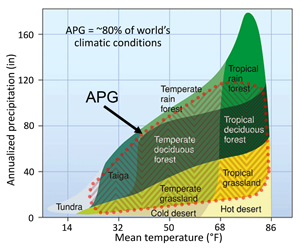A Test for All Seasons: ATC’s One-Stop Climatic Testing
By Robert McKelvey,
Office of the Commander, ATC

At ATEF, a Soldier operates a truck equipped with AMAS-BWASK to assess the situational awarness abd active safety capabilities of the system.
Will communication systems work around trees……or buildings
Will vehicles get stuck driving through mud?
Will navigation sensors operate effectively in falling snow?
Environmental concerns such as these in military testing require a facility in which vehicles and systems can demonstrate their full capability in a variety of climatic situations.
This is what sets ATC apart from other test facilities: the natural distribution of temperature and precipitation that creates environmental conditions resembling 80% of worldwide climates.
In short, every conceivable climatic testing scenario can be explored rather than simulated, and testing can be planned in a reliable, consistent way.
The climate of a program’s operational environment will affect how systems, subsystems, components, and support packages perform and, more notably, fail. Bushings, bearings, brake lines, hydraulic hoses, and body panels are all susceptible to accelerated wear. Sensors, seals, filters, belts, switches, intakes, exhausts, accesses, and wheels are all prone to being hit, displaced, or jammed by mud. Water penetrates, rust develops, corrosion decays, ice binds, salt grinds, vegetation blinds, and dust chokes. All of these effects, and more, must be assessed when exploring program affordability, suitability, reliability, availability, and maintainability.
When analyzed using independent climate classification systems, ATC has unquestionably featured dependable temperature and precipitation cycles throughout the past 10 years. The Köppen-Geiger classification, based on the concept that native vegetation is the best expression of climate, is divided into five main groups representing climate conditions, four of which -- A, C, D, and E -- ATC has reliably demonstrated; and eight of the ten Whittaker Biome classifications (Temperate Deciduous Forest, Temperate Grassland, Tropical Grassland, Taiga, Tropical Deciduous Forest, Tropical Rainforest, Temperate Rainforest, and Tundra) have been met every year between 2006 and 2015.
These climatic conditions, and ATC’s proximity to the Chesapeake Bay, lead to clockwork seasonal changes and vegetation cycles, creating a consistent environment. ATC testing uses these known factors to realistically assess how programs will perform in their intended operational environments and to efficiently execute testing. Program costs — especially Operating and Sustainment —cannot be adequately planned without accounting for climatic conditions. ATC has world-leading expertise evaluating climatic effects and life cycle elements during performance, reliability, suitability, and survivability testing. ATC’s subject matter experts, and their unique operationally authentic outdoor laboratory, can help program managers field effective, suitable, and survivable systems.
Testing at ATC does not result in an evaluation affecting just one Soldier in one kind of environment; all scenarios can be realistically planned, including the testing itself.
You are now leaving www.atc.army.mil and entering another site. You will automatically be forwarded to the target page within five seconds.
